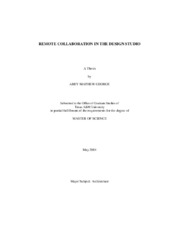| dc.description.abstract | Information technology offers many tools for promoting collaboration and communication in architectural design. A growing number of companies and individuals are adopting computer-based techniques to facilitate remote collaboration between geographically distributed teams. Thus, it is important to investigate the use of technology in developing collaborative tools for architects, especially as required training in architectural education. This research explores the feasibility of augmenting communication in the design studio using a web-based collaboration tool. A prototype was developed for an integrated system that allows for streaming media, real-time collaboration, and multi-way video, audio and text messaging, tailored specifically to the needs of a distributed architectural design studio. The Collaborative Online Architectural Design Studio (COADS) is based on a three-tier client-server structure consisting of an interface tier, an application-logic tier and a data tier. COADS allows role-based participation for students and teachers, facilitating collaboration over design sketches and presentations using personal computers equipped with a microphone and a web-cam. The system was developed and subjected to usability testing in a design studio consisting of graduate-level students of architecture. The participants were required to use COADS for conducting peer evaluations of designs for their class project and subsequently, to answer a questionnaire assessing the usability of the system. The analysis showed that COADS has definite advantages as a tool to augment communication in the design studio. The biggest advantage was that participants could get immediate feedback about their designs from their peers, irrespective of their location. COADS was also relatively easy to set up on end-user machines and provided an integrated point for accessing relevant studio resources from a single location. The disadvantages were mostly due to the limitations of the hardware on end-user machines such as small screen sizes, low quality microphones and web-cams. Further, the collaborative whiteboard within COADS lacked essential tools, such as pan/zoom and erase/undo tools, which reduced its usability. In conclusion, systems such as COADS can effectively augment communication within the architectural design studio. However, they need to be integrated closely with the course structure, right from the introductory stage of the project to the final presentation stage. | en |


